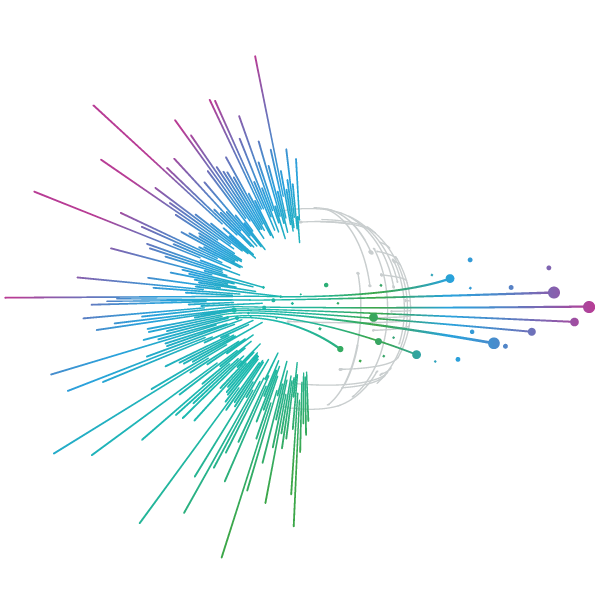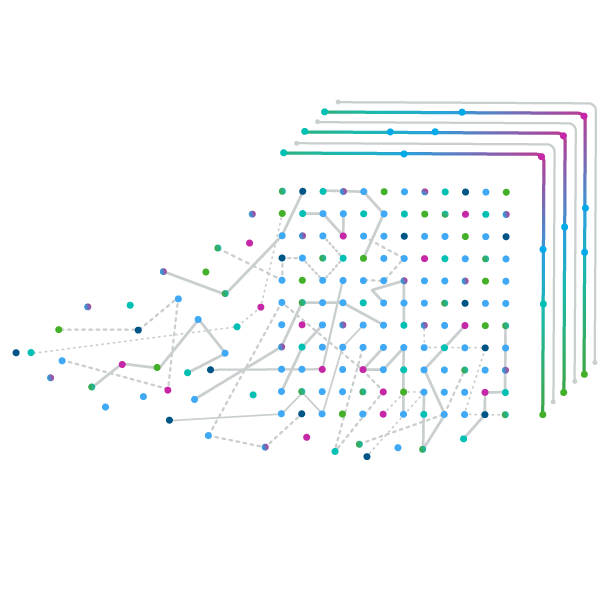Take advantage of the latest tools, techniques, and deep healthcare expertise to create scalable resources, precision insights, and actionable ideas.






















Overall, 2023 was a year marked by significant progress in terms of therapeutic innovation. Notable examples include the approval of the first CRISPR therapy, and the readout of Novo Nordisk’s SELECT trial which demonstrated the significant cardiovascular benefits of obesity agent semaglutide (Wegovy). However, 2023 was also a year in which challenges from the COVID-19 pandemic persisted: overall uptake of innovative launches remained well below pre-pandemic uptake in the major markets, and global volume of innovative prescription medicines failed yet again to recover to 2019 levels.1 This analysis examines major trends of last year, based on IQVIA data from MIDAS, MIDAS Disease and Analytics Link.
Despite the challenges, the global prescription medicines market grew in value by 11% at list prices last year (excluding COVID-19 vaccines and treatments) – the fastest growth since the start of the pandemic. Biologics were core drivers of this growth, shown in Figure 1: despite representing only a fraction of global prescription medicine volume, biologics are responsible for an increasingly large proportion of value.
Last year, biologics accounted for around two thirds of global value growth, and these were predominantly specialty biologics for immunology and oncology, such as risankizumab (Skyrizi), dupilumab (Dupixent) and pembrolizumab (Keytruda). For traditional biologics, the type 2 diabetes and weight-loss treatments semaglutide (Ozempic/Wegovy/Rybelsus) and tirzepatide (Mounjaro/Zepbound) dominated growth; the rise of these treatments is among the most momentous developments in the industry in 2023. For small molecules, CDK4/6 inhibitors and SGLT2 inhibitors were key to driving growth in the specialty and traditional markets respectively.
Figure 1: Global Growth in the biopharmaceutical industry

Notes: Growth rates at constant exchange rates; sales are at ex-manufacturer list price; excludes COVID-19 vaccines and therapeutics; EMEA – Europe, Middle East and Africa; APAC – Asia and Pacific; LATAM – Latin America. Other EMEA includes Russia
Source: IQVIA EMEA Thought Leadership; IQVIA MIDAS QTR Q4 2023; Rx-only; Copyright © 2024 IQVIA. All rights reserved
From a therapy area perspective, oncology remained top globally in 2023, worth $221 bn at ex-manufacturer list price. Oncology has historically been a growth engine of the biopharmaceutical industry and will continue to be so for the next five years.2
Solid tumour therapies comprise three quarters of the global oncology market. For the three highest-value solid tumour types – breast cancer, non-small cell lung cancer (NSCLC) and prostate cancer – growth has historically been high, and will increase further in the next five years, as Figure 2 illustrates. As a result, together these three tumour types are expected to account for over half of all oncology absolute value growth in the next five years.
For haematological malignancies, recent market growth has been less consistent, partly due to the entry of generics. Multiple myeloma currently has the largest market share, but its growth will continue to decelerate in the coming years as lenalidomide and bortezomib generics drive down treatment cost.
Among the smaller indications, small cell lung cancer and liver cancer have stand-out historical growth: in both cases, this is caused by two checkpoint inhibitors. Checkpoint inhibitors have become major growth drivers for the oncology market overall, and other classes of innovative biologics are also growing rapidly. Notable examples include antibody-drug conjugates (ADCs) and bi-specific antibodies, although they have relatively small market shares.
Figure 2: Oncology market dynamics by tumor type, 2018-28

Notes: *includes Q4 2023 forecast data; NSCLC – Non-Small Cell Lung Cancer; NHL – Non-Hodgkin Lymphoma; Leukaemia data includes Chronic Myeloid Leukaemia, Chronic Lymphoid Leukaemia, Acute Myeloid Leukaemia; constant exchange rate for sales
Source: IQVIA EMEA Thought Leadership, IQVIA Analytics Link accessed March 2024; Copyright © 2024 IQVIA. All rights reserved
Biologics also have a central role in immunology – the third-largest therapy area at list price, at $167 bn in 2023 (Figure 3). Immunology indications can be classified as either autoimmune or allergic inflammation, and the autoimmune indications dominate immunology sales, with a market share of 91% in 2023. Of these, rheumatoid arthritis and psoriasis are the most valuable indications, each making up around 25% of autoimmune sales.
Despite its relatively small market size, the allergic inflammation segment is growing at nearly three times the rate of autoimmune, although it is now beginning to mature. The stand-out product in allergic inflammation has been dupilumab (Dupixent), which dominates sales in both atopic dermatitis and allergic asthma – the major indications in allergic inflammation.
For immunology as a whole, the United States is by far the largest market, with a 76% market share in 2023. This is partly due to the successful biosimilars penetration in Europe, which has increased competition and lowered prices.
Figure 3: Immunology market performance and growth

Notes: Total spending calculated at Constant Exchange Rate (CER) Immunology market defined as following diseases and ATC3 codes: Rheumatoid Arthritis, Crohn’s Disease, Psoriasis, Psoriatic Arthritis, Hidradenitis Suppurativa, Ulcerative Colitis, Ankylosing Spondylitis and other spondylarthritis, Allergic Asthma, Urticaria, Lupus, Nasal polyps, Esophagitis, Prurigo Nodularis, Alopecia Areata, Vitiligo. ATC3 codes: A7E, D5B, D5X, L4B, L4C, L4X M1C,
Source: IQVIA EMEA Thought leadership; IQVIA MIDAS Disease MTH 12 2023; Copyright © 2024 IQVIA. All rights reserved
Biosimilars are important not just in immunology, but across the whole pharmaceutical market, especially the highest-value therapy areas. Biosimilars can drive down treatment cost, and as healthcare systems and doctors have become more comfortable with prescribing biosimilars since the first launched in 2006, uptake rates have increased.
In January 2023, adalimumab biosimilars entered the US market, following entry in Europe in 2018. Figure 4 shows that in Japan and the UK, adalimumab biosimilar uptake by volume is comparable to that of other molecules, whereas in the US, uptake in the first year is notably lower. The primary reason for low uptake is the challenging “rebate wall” biosimilar manufacturers need to overcome to incentivise their biosimilars on formularies. Despite their low uptake rates, adalimumab biosimilars have driven down the cost of treatment in the US by increasing discounts and rebates offered by AbbVie, the originator.
Figure 4: Biosimilar uptake rates by country

Notes: Includes subcutaneous formulations for trastuzumab
Source: IQVIA EMEA Thought Leadership; IQVIA MIDAS MTH Dec 2023; Copyright © 2024 IQVIA. All rights reserved
In 2023, interest in obesity treatments exploded, following the commercial success of weight-loss products such as semaglutide (Wegovy). Forecasts place the obesity market at anywhere from $39 - $131 bn by 2028, as Figure 5 indicates, which could make obesity the fourth-largest therapy area in just a few years’ time.2
The size of the future market is highly dependent on payers’ appetite for reimbursement. Spending on obesity agents is currently mainly out-of-pocket, and in some countries – such as Germany, where until very recently weight-loss products were seen as purely cosmetic – public reimbursement is either heavily restricted or entirely prohibited3. The SELECT trial readout showed that semaglutide significantly reduces MACE-3 cardiovascular events, and compelling evidence of this nature will be crucial to convincing payers of the cardiovascular benefits of other obesity products, and the need for reimbursement.4
Figure 5: Global obesity spending and growth forecast

Source: IQVIA Forecast Link, IQVIA Institute, Dec 2023 Global Use of Medicines 2024: Outlook to 2028. Report by the IQVIA Institute for Human Data Science.
Looking ahead, global uptake of innovation will continue to be compromised by the healthcare capacity gap: healthcare systems do not have the capacity to meet the demands of new, innovative therapies. In addition, extensive crowding in many major indications is a challenge: this is particularly the case for immunology, where innovators are being forced to seek opportunities in smaller, underserved indications.5 This, combined with the entry of biosimilars for blockbuster immunology products, will severely hamper value growth in immunology in the coming years.
However, the oncology market will continue to expand rapidly, with increasing interest in new combinations, such as immunotherapies and ADCs, as well as in new drug modalities, such as radioligand therapies. Obesity may join the well-established “mega” therapy areas, as high unmet need, paired with great innovation, will drive dramatic growth over the next five years.
This blog relates to the "MIDAS Early Bird: Uncovering the defining trends of 2023 and what these hold for 2024" webinar. To dive into more insights, you can access the on demand webinar here.
1 IQVIA MIDAS data
2 The IQVIA Institute’s Global Use of Medicines 2024 report https://www.iqvia.com/insights/the-iqvia-institute/reports-and-publications/reports/the-global-use-of-medicines-2024-outlook-to-2028
3 https://www.reuters.com/business/healthcare-pharmaceuticals/germanys-health-insurance-could-cover-wegovy-strokes-heart-conditions-agency-2024-03-22/
4 2024: The obesity market’s inflection point? - IQVIA
5 https://www.iqvia.com/blogs/2024/03/seeking-new-horizons-where-innovators-find-opportunities-in-a-fast-changing-immunology-landscape
Related solutions
Be proactive about growing your brand using the latest in data, analytics, and domain expertise.
Analyze industry leading sales and medical data in a standardized and comparable way, including cross-country analysis of performance and additional insights into global and regional markets.
Maximize the value of your brand with personalized, precise, and efficient communications.
Measure the performance of your sales force and marketing channels, adapt your commercial strategy and gain real world competitive insights.





